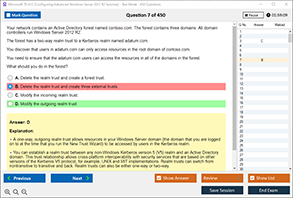Introduction
In today’s interconnected digital landscape, network security is a critical concern for organizations of all sizes. Cyber threats are evolving rapidly, and businesses must adopt robust strategies to protect sensitive data and maintain operational integrity. One such strategy involves the use of a Demilitarized Zone, commonly referred to as a DMZ. But what is the purpose of a DMZ, and why is it a cornerstone of modern network security? In this detailed guide, brought to you by the experts at DumpsQueen, we will explore the concept of a DMZ, its role in safeguarding networks, and how it contributes to a secure IT infrastructure. Whether you’re an IT professional, a business owner, or simply curious about cybersecurity, this article will provide valuable insights into the importance of a DMZ.
At DumpsQueen, we are committed to empowering individuals and organizations with the knowledge and tools needed to excel in the world of IT and cybersecurity. Our official website, DumpsQueen, offers a wealth of resources to help you stay ahead in this dynamic field. Let’s dive into the purpose of a DMZ and uncover why it’s an essential component of network architecture.
Understanding the Concept of a DMZ
A DMZ, or Demilitarized Zone, is a specialized network configuration designed to enhance security by creating a buffer between an organization’s internal network and the external world, typically the internet. The term “demilitarized zone” originates from military contexts, where it refers to a neutral area separating conflicting parties. In cybersecurity, the DMZ serves a similar purpose: it acts as a neutral zone where external-facing services can reside without directly exposing the internal network to potential threats.
The DMZ is strategically placed between the internal network (often called the LAN, or Local Area Network) and the external network (such as the internet). It is typically configured using firewalls to control traffic flow, ensuring that only authorized access is granted. By isolating public-facing services like web servers, email servers, or file transfer servers in the DMZ, organizations can minimize the risk of unauthorized access to sensitive internal systems.
At DumpsQueen, we emphasize the importance of understanding foundational concepts like the DMZ to build secure and resilient IT environments. A well-implemented DMZ can make the difference between a secure network and one vulnerable to cyberattacks.
Why Organizations Need a DMZ
The primary purpose of a DMZ is to enhance network security, but its role extends far beyond that. Organizations rely on DMZs to balance accessibility with protection. For example, businesses often need to provide customers or partners with access to certain services, such as a company website or an online portal. However, allowing direct access to the internal network would be risky, as it could expose sensitive data or critical systems to malicious actors.
A DMZ addresses this challenge by creating a controlled environment where external users can interact with designated services without penetrating the internal network. If a server in the DMZ is compromised, the attacker’s ability to move deeper into the network is restricted, thanks to the firewall rules and segmentation that define the DMZ’s boundaries.
Moreover, a DMZ helps organizations comply with regulatory requirements. Many industries, such as finance and healthcare, are subject to strict data protection standards like PCI DSS or HIPAA. By isolating public-facing systems in a DMZ, organizations can demonstrate that they are taking proactive steps to secure sensitive information.
At DumpsQueen, we recognize that implementing a DMZ is a critical step for organizations aiming to protect their digital assets. Our resources on the official DumpsQueen website provide in-depth guidance on network security practices, including the deployment of DMZs.
How a DMZ Works in Practice
To fully appreciate the purpose of a DMZ, it’s helpful to understand how it functions within a network. A typical DMZ configuration involves two firewalls: one facing the external network (the internet) and another separating the DMZ from the internal network. This setup is often referred to as a “dual-firewall architecture.”
The external firewall filters incoming traffic from the internet, allowing only specific types of requests (e.g., HTTP or HTTPS for a web server) to reach the DMZ. The internal firewall, on the other hand, tightly controls communication between the DMZ and the internal network, ensuring that only necessary interactions are permitted. For instance, a web server in the DMZ might be allowed to query a database on the internal network, but direct access to the database server would be prohibited.
In some cases, organizations use a single firewall with multiple interfaces to create a DMZ. While this approach is less expensive, it may not provide the same level of security as a dual-firewall setup. Regardless of the configuration, the goal remains the same: to create a secure, isolated environment for public-facing services.
By leveraging a DMZ, organizations can monitor and log traffic more effectively, detect suspicious activity, and respond to threats before they escalate. At DumpsQueen, we advocate for proactive network monitoring and encourage IT professionals to explore our resources for mastering DMZ configurations.
Key Benefits of Implementing a DMZ
The adoption of a DMZ offers several advantages that contribute to an organization’s overall security posture. First and foremost, it provides an additional layer of protection. Even if a hacker manages to compromise a server in the DMZ, the internal network remains shielded, making it significantly harder for the attacker to access critical systems or data.
Another benefit is improved performance for public-facing services. By hosting these services in a dedicated DMZ, organizations can optimize their configurations for speed and availability without compromising the security of the internal network. This ensures that customers and partners enjoy a seamless experience when interacting with the organization’s online platforms.
A DMZ also enhances flexibility. Organizations can scale their public-facing services by adding new servers to the DMZ without altering the internal network’s structure. This modularity is particularly valuable for businesses experiencing rapid growth or fluctuating demand.
Finally, a DMZ supports incident response efforts. Because the DMZ is isolated, IT teams can contain and mitigate threats without disrupting core operations. This containment capability is crucial for minimizing downtime and maintaining business continuity.
DumpsQueen is dedicated to helping IT professionals unlock these benefits through expert guidance and practical resources. Visit our official website at DumpsQueen to explore tools and training materials tailored to network security.
Common Use Cases for a DMZ
The versatility of a DMZ makes it applicable to a wide range of scenarios. One of the most common use cases is hosting web servers. A company’s website is often the first point of contact for customers, but it’s also a prime target for cyberattacks. By placing the web server in a DMZ, organizations can ensure that visitors can access the site while keeping the internal network secure.
Email servers are another frequent candidate for the DMZ. Email is a critical communication tool, but it’s also a common vector for phishing attacks and malware. A DMZ allows organizations to filter and process email traffic in a controlled environment, reducing the risk of malicious content reaching internal systems.
File transfer services, such as FTP servers, are also commonly placed in a DMZ. These services enable secure data sharing with external partners, but they can be vulnerable to exploitation if not properly secured. A DMZ ensures that file transfers occur in a protected zone, safeguarding both the organization and its partners.
E-commerce platforms, remote access gateways, and even IoT devices are other examples of systems that can benefit from a DMZ. At DumpsQueen, we provide insights into these use cases and more, helping you design DMZ architectures that align with your organization’s needs.
Challenges and Considerations When Setting Up a DMZ
While a DMZ is a powerful tool for enhancing security, it’s not without its challenges. One of the primary considerations is cost. Implementing a DMZ requires investment in hardware (such as firewalls and servers), software, and skilled personnel to manage the configuration. For small businesses with limited budgets, this can be a significant hurdle.
Another challenge is complexity. Designing and maintaining a DMZ demands a deep understanding of network architecture and security principles. Misconfigurations, such as overly permissive firewall rules, can undermine the DMZ’s effectiveness and create vulnerabilities.
Organizations must also ensure that their DMZ remains up to date. As new threats emerge, firewall rules, server configurations, and monitoring tools need to be adjusted to address evolving risks. Regular audits and penetration testing are essential for verifying the DMZ’s integrity.
Despite these challenges, the benefits of a DMZ far outweigh the drawbacks when implemented correctly. At DumpsQueen, we offer resources to help you navigate these complexities and build a DMZ that meets your security objectives.
Free Sample Questions
Question 1: What is the primary purpose of a DMZ in network security?
A) To store sensitive data securely
B) To provide a buffer between the internal network and external users
C) To manage internal employee access
D) To host private databases
Answer: B) To provide a buffer between the internal network and external users
Question 2: Which of the following services is most commonly placed in a DMZ?
A) Internal HR database
B) Company web server
C) Employee workstations
D) Core financial systems
Answer: B) Company web server
Question 3: What is a key benefit of using a DMZ?
A) Eliminates the need for firewalls
B) Reduces the cost of network hardware
C) Enhances security by isolating public-facing services
D) Simplifies internal network management
Answer: C) Enhances security by isolating public-facing services
Question 4: What is a common challenge when implementing a DMZ?
A) Lack of available servers
B) Complexity of configuration
C) Inability to monitor traffic
D) Reduced network performance
Answer: B) Complexity of configuration



